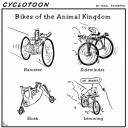Finding a bicycle that fits & the «ideal position».
 Finding a good position on a bicycle is not an exact science because there is no one standard sized frame, body shape or «ideal position». Different frames having the same seat tube length will have different top tube lengths. Look around and you will see that some manufacturers are reknowned for this. I still haven’t figured it out. It doesn’t help that some frames are measured differently. Have a look at the recent article I wrote concerning measuring bicycle frame sizes.
Finding a good position on a bicycle is not an exact science because there is no one standard sized frame, body shape or «ideal position». Different frames having the same seat tube length will have different top tube lengths. Look around and you will see that some manufacturers are reknowned for this. I still haven’t figured it out. It doesn’t help that some frames are measured differently. Have a look at the recent article I wrote concerning measuring bicycle frame sizes.
I’ve ridden quite a few bikes now, in many sizes. I’ve also been lucky enough to supply rental bikes here in Tenerife for hundreds of experienced cyclists ranging in height from 152cm to 203cm (5’1″ – 6″8″). I’ve listened to their feedback regarding how they felt about the way their bike fit. For me, you can only determine your unique «100% fit» by gaining your own experience about bikes that have fitted well in the past – this is a skill which can only be learned with time.
The best way is simply to ride as many different bikes, saddles, stems, handlebars and pedals as you can. Start with a bike you think will fit best and then alter the saddle and stem positions until you find what works best for you. Also try different bikes in a range of incremental sizes if you can. I have the view that obtaining your ideal bike is basically a process of trial and error. My first bike fit relatively well. I learned a lot of things about my subsequent bikes. Now I know that my «ideal frame size» is 56cm. I can ride a 55 or 57cm bike but they feel slightly too small or too big for me. This «ideal frame measurement» as I like to call it has taken years to determine, and will probably change a little as I got older (and shorter!).
I’m probably in the minority here, but in my humble opinion, fitting services (including stationary fitting machines) aren’t ideal either as they don’t give you a feel of how it feels to actually ride that particular sized bike that they are suggesting for 5 or more hours. For instance, a 140mm stem might be what you require on paper & it might even feel great on a stationary bike. Ride it, and you’ll soon discover the extreme difference it makes to the handling compared with a 120mm stem.
I’m a big believer in finding proportional length cranks, stems, wheels, etc. Unfortunately, people are STRONGLY biased in favour of 700c wheels. For small riders, 650c is a better choice, if only because of the toe-overlapping-the-front-wheel issue. If someone doesn’t agree, they’re most likely taller than 5’6″ (I am 5’11»).
On bicycle forums, I’ve noticed that some people tend to suggest a 110mm stem on a road bike, regardless of the size of the bike (somehow thinking it’s the «magical stem length»). Again, they’re being somewhat biased, based on their own size. 110mm is not what smaller and larger riders request in practice (and 90% of my clients know what they’re doing already). I’ve seen people ask for everything from a 61cm frame with a 100mm stem, to a 53cm frame with a 120mm stem.
Even changing components like your saddle and pedals can significantly alter your position on the bike. For example, going from the most common traditional Look Delta pedals to vista pedals will lower your whole position on the bike by as much as ~25mm. In that case, you’d even need to consider lowering your handlebars by a proportional amount.
Many cyclists forget about the asymmetric nature of bicycle fit. I have a leg length discrepancy and so do a lot of people. Technically, you need to be measured and then fitted for each side of your body independantly. I have a hunch that a lot of «fitters» don’t do this properly, don’t have time, or else forget.
Different bikes handle suprising differently; the geometry of a bike makes an incredible difference to the way a bike rides. The seat tube and head tube angles are the most important consideration for a bike’s handling (this will surely be covered soon in another article). Lastly, the type of bike that you buy and the position you decide upon will depend on the bike and the type of riding you expect to be doing. For example, my DH rig vastly differs from my road bike. Both are perfect for their intended purpose.





Sizing is a difficult thing to get right and always causes me some grief. In my humble opinion, it’s not something that someone can tell you in one fitting session. It takes actual riding experience to hone in on. I’ve only ever bought 3 road bikes for myself previously and I’m about to get a Pinarello.
In my case, the last time I measured myself I was 178cm. After riding various bikes over the years (especially in the last two), I’ve figured out that my ideal top tube length is probably 56.5cm (with a 1cm allowance on either side). If I had to purchase an FP2, I’d go for the 56cm, which has a 56.5 cm TT.
This is how I determined what’s best for me for example:
On the last 55cm bike I tried (Decathlon comp 9.2 with a 555mm top tube), the reach while seated was good, but with with stems less than or equal to 100mm,, my knees would interfere with the handlebar when climbing. Also the standard seatpost was too short & the seat was about as far back as it could go despite a 25cm layback seatpost. Conclusion: this frame is still rideable but on the small side.
My main road bike (57cm Kestrel 500EMS) has a 57.5cm top tube. With a standard bar & 110mm stem, it sometimes felt a bit long when seated. Even though I didn’t realise it at the time, I was stretched out too much & I never used the handlebar drops. By sheer luck, I swapped to a bar (3t bio-morphe) with a compact reach + drop and now it’s close to perfect. Even so, using a standard 25mm layback seatpost, the seat is about as far forward as it can go, so it’s still not what I’d call ideal. It would be better for me to use a seatpost with zero setback, all this suggests to me that it is on the large size. Having said that, only three sizes were made for this frame, so I still think it is a better choice than the next size down.
However, without a doubt, the best fitting bike that I own at the moment is a Medium Mrazek (56-57cm tt depending on how you measure it). I can put on stems between 90 & 120mm and not notice much of a difference. It seems to fit like a glove. Once again, only three sizes were made, but I’m positive the large (with 59cm tt) is too big because I actually own all three sizes.
I’m going now for a Pinarello F3:13. It has a 56cm tt, but it’s labelled as a 55cm bike. Needless to say, I’m a little bit nervous about this, but going from my past measurements & looking at the geometry, just like the Mrazek, it should fit me very well with a standard bar and 110mm stem. I also browsed online at what other people had to say about fit. The next size up for the F4:13 (57cm) has a 57.5cm tt and seems to be a good fit for people around 182cm or even a bit more. But the 56cm tt measurement on the 55cm F4:13 is closer to 56.5cm (my ideal tt) than 57.5cm is.
It still might be a wee little bit short, but as I’m 31, I’m only going to shrink as I get older. 😆